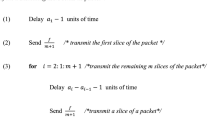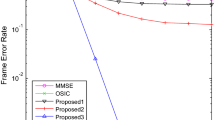Abstract
Multimedia IoT has become a new megatrend foreseen to impact many application areas. Random access is the major bottleneck for achieving the goal of being real-time. In this paper, we propose chained packet based multichannel architecture for random access, where the selection of a time slot/channel pair is based on Finite Projective Plane and random numbers and the packets of transmitting nodes are formed as a chain through logical XOR operations with adjacent packets. To retrieve packets in collision time slots, the packets involved in a collision time slot are extracted one by one using the neighboring singleton packet. Retrieving collision time slots not only increases the throughput but also improves the quality of service. However, the collision time slots that form a closed loop in the chained packet transmission cannot be resolved. We analyze the throughput of the chained packet approach in comparison to the plain packet approach and perform simulation runs for verification. The chained packet transmission is well suited for moderate to heavy load and the number of channels is rather limited. The results of analysis and simulation runs show that the improvement in throughput is up to 50% using chained packet transmission.












Similar content being viewed by others
Data availability
The datasets generated or analyzed during the current study are available from the author by email. The entire manuscript belongs to the category of theoretical research, all data, i.e., figures or tables were generated from the derived mathematical formulations (equations listed in order). Simulation results along with MATLAB codes are available by email request. All data and materials generated or analyzed during the current study are available from the author by email.
Code availability
Related software application or custom code during the current study are available from the author by email.
References
Vaezi, M., Azari, A., Khosravirad, S. R., Shirvanimoghaddam, M., Azari, M. M., Chasaki, D., & Popovski, P. (2022). Cellular, wide-area, and non-terrestrial IoT: A survey on 5G advances and the road toward 6G. IEEE Communications Surveys and Tutorials, 24(2), 1117–1174.
Nauman, A., Qadri, Y. A., Amjad, M., Zikria, Y. B., Afzal, M. K., & Kim, S. W. (2020). Multimedia internet of thing: A comprehensive survey. IEEE Access, 8, 8202–8250.
Al-Fuqaha, A., et al. (2015). Internet of things: A survey on enabling technologies, protocol, and applications. IEEE Communications Surveys and Tutorials, 17(4), 2347–2376.
Siriwardhana, Y., et al. (2021). A survey on mobile augmented reality with 5G mobile edge computing: Architectures, applications, and technical aspects. IEEE Communications Surveys and Tutorials, 23(2), 1160–1192.
Kovalchukov, R., Moltchanov, D., Pirskanen, J., Säe, J., Numminen, J., Koucheryavy, Y., & Valkama, M. (2022). DECT-2020 new radio: The next step toward 5G massive machine-type communications. IEEE Communications Magazine, 60(6), 58–64.
Abramson, N. (1977). The throughput of packet broadcasting channels. IEEE Transactions on Communications, 25, 117–128.
Roberts, L. G. (1975). ALOHA packet systems with and without slots and capture. ACM SIGCOM Computer Communications Review, 5(2), 28–42.
Choi, J. (2016). On the power allocation for a practical multiuser superposition scheme in NOMA systems. IEEE Communications Letters, 20(3), 438–441.
Sun, Q., Han, S., Chin-Lin, I., & Pan, Z. (2015). On the ergodic capacity of MIMO NOMA systems. IEEE Wireless Communications Letters, 4(4), 405–408.
Mengali, A., Gaudenzi, R. D., & Stefanovi, C. (2018). On the modeling and performance assessment of random access with SIC. IEEE Journal on Selected Areas in Communications, 36(2), 292–303.
Guo, D., & Wang, C.-C. (2008). Multiuser detection of sparsely spread CDMA. IEEE Journal on Selected Areas in Communications, 26(3), 421–431.
Razavi, R., Hoshyar, R., Iman, M. A., & Wang, Y. (2011). Information theoretic analysis of LDS scheme. IEEE Communications Letters, 15(8), 798–800.
Moon, S., et al. (2018). SARA: Sparse code multiple access-applied random access for IoT devices. IEEE Internet of Things Journal, 5(4), 3160–3174.
Woo, T. K. (2019). FRAM: Framed ALOHA for 5G super real-time multimedia random access with packet slicing. Wireless Personal Communications, 106, 1253–1073.
Bose, R. C. (1938). On the application of the properties of Galois fields to the problem of construction of hyper-Graeco-Latin squares. Sankhyā, 3, 323–338.
Hughes, D. R., & Piper, F. C. (1973). Projective planes. Springer.
Woo, T. K., Fu, C. H. (2022). Random access with joint uplink/downlink resource allocation for multimedia tactile internet. Submitted to Wireless Personal Communications.
Koraitim, H., & Tohmé, S. (2000). Performance analysis of multiple access protocols for multimedia satellite networks. IEEE Journal on Selected Areas in Communications, 18(9), 1751–1763.
Zhang, R., Ruby, R., Pan, J., Cai, L., & Shen, X. (2010). A hybrid reservation/contention-based MAC for video streaming over wireless networks. IEEE Journal on Selected Areas in Communications, 28(3), 389–398.
Cheung, M., et al. (2012). Utility optimal random access for wireless multimedia networks. IEEE Wireless Communications Letters, 1(4), 340–343.
Funding
The authors declare that no funds, grants, or other support were received from any organization.
Author information
Authors and Affiliations
Contributions
The entire paper is written by T-KW and C-HF, including the concept, modeling and simulation, mathematical analysis, and so on.
Corresponding author
Ethics declarations
Conflict of interest
The authors have no relevant financial or non-financial interests to disclose in any forms.
Additional information
Publisher's Note
Springer Nature remains neutral with regard to jurisdictional claims in published maps and institutional affiliations.
Rights and permissions
Springer Nature or its licensor (e.g. a society or other partner) holds exclusive rights to this article under a publishing agreement with the author(s) or other rightsholder(s); author self-archiving of the accepted manuscript version of this article is solely governed by the terms of such publishing agreement and applicable law.
About this article
Cite this article
Woo, TK., Fu, CH. Chained Packets for Multimedia Random Access in Next Generation Internet of Things. Wireless Pers Commun 132, 409–432 (2023). https://doi.org/10.1007/s11277-023-10616-9
Accepted:
Published:
Issue Date:
DOI: https://doi.org/10.1007/s11277-023-10616-9




